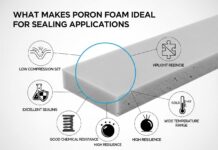The hardened steel tubing is now a valuable item that is used in commercial and industrial work which requires high structural performance under pressure. It is favored because of its strength against force as well as vibration and prolonged wear, which are all used in machinery framing and as protective barriers. Companies that rely on long-lived metal objects are always trying to find a solution as to how their systems can be made more resilient, and hardened steel tubing could provide a secure direction in which they can arrive at it. Although other materials could be used to reinforce individual functions, hardened steel is the material that is characterized by being easier to handle, multi-purpose, and more economically viable. Hardened steel tubing continues to be a central feature of high impact environments even in the industries where the companies purchase the aluminum sheet metal on the internet to use in light projects.
Understanding Hardened Steel Tubing
The hardened steel is made more of hard steel by heat treatments which enhance its strength and long life. Heat and rapid cooling of the steel transforms its internal structure into a more resistant and solid material, which is tougher and more resilient, manufactured by the manufacturers. This has enhanced microstructure, which enables the tubing to withstand a higher level of stress before deformation, which is good in protecting systems, heavy machinery and structural systems where the same force recurs.
The increased level of hardness does not only increase the strength but also the ability of the material to withstand dents, wear and sudden impacts. When selected and integrated well, hardened steel tubing provides a more durable structure that minimizes the cost of maintenance and eliminates the chances of failure. What it brings is a more reliable and stable structure that still works even in the most adverse circumstances.
Selecting the Right Tubing Type
The appropriate grade and type of hardened steel tubing contributes a great deal to impact resistance and is therefore a choice that needs to be done properly. The level of hardness and alloy composition have impacts on the stress handling and the load distribution in the tubing. There are those that demand extreme levels of toughness and then there are those that demand a balance of strength and flexibility. The awareness of these differences will assist in ensuring that the desired level of protection needed in the project will be achieved using the selected tubing.
Performance is also largely reliant on shapes. The impact on square, rectangular and round shapes is different. Frame and enclosure rigidity This is usually more rigid using square and rectangular tubing, whereas round tubing is more effective in the distribution of force when used in machinery or guarding. The alignment of the tubing characteristics with the use results in stronger, safer and durable results.
Strengthening Through Structural Design
The natural hardened steel tubing strength is boosted by proper structural design. Engineers tend to pay attention to the distribution of loads and organizing components in such a manner that a large amount of stress is removed on a specific point. With the even distribution of forces with the help of the design, there is a reduced strain on the tubing and can sustain higher impacts without bending and breaking.
Reinforcement is also a major issue in increasing resistance. Increasing important linking points, cross bracing, or strategic alignment can provide a framework that can be more responsive to dynamic force. Such solutions in design contribute to the longevity of the whole building and enhance general stability in the conditions where physical force is a frequent issue.
Considering Material Alternatives for Support
There are certain projects that use hardened steel tubing as the main structural element though it is also beneficial to use lighter metals in the non load bearing parts. In such instances, teams usually buy aluminum sheet metal online to offset the steel parts that are heavy. Aluminum panels have the potential to trim down the total system weight with hardened steel tubing to perform heavy impact-related functions. This moderation approach helps to maintain the performance without compromising the efficiency.
Complementary materials are also beneficial in that they facilitate fabrication and reduce the total expenses. In case when the structural impact load is taken by tubes of hardened steel and the secondary functions succeed the role of aluminum, companies attain sustainability and cost-efficiency. Such an approach reinforces the end result and makes the system flexible enough to meet various commercial requirements.
Improving Performance During Fabrication
The manner in which the steel tubing is treated during the fabrication process influences its resistance to long term impact. The hardness of the metal can be altered by cutting, welding, and bending, as well as the weak areas may be created in case of their implementation without due care. Good craftsmen who are knowledgeable of the characteristics of hardened steel make sure that the heat levels and cutting processes do not affect the reinforced structure of the tubing.
The techniques of joining are also important. Controlled welds that have reduced heat input ensure that the metal does not become too soft and the integrity of the tubing is preserved. Accuracy in the manufacturing process means that the finished product would be able to withstand a hard-duty environment.
Enhancing Resistance Through Coatings and Finishes
Hardened steel tubing is further coated with protective types of coatings that enhance its durability. Although the material is tough, coatings assist in protecting the material against wear of the surface, corrosion and environmental aspects that may diminish the material with time. Galvanizing, powder coating, and custom industrial finishes are also possible and these maintain the tubing and can increase its service life.
The finishes also come in handy in outdoor or high moisture areas where corrosion is likely to lower the impact resistance. With the tubing in good structural condition and not in deterioration, its strength to absorb and resist the force is much greater.
Ensuring Proper Installation and Maintenance
Installation is a significant role towards making sure that hardened steel tubing works as desired. The presence of secure attachment, proper alignment, as well as proper torque on fasteners all help to avoid unnecessary strain. A properly installed tubing will make a system more stable and impact resistant.
Performance is also safeguarded by routine maintenance. Often, it is possible to notice the early signs of wear and modify or repair the wear before minor problems begin to cause serious troubles. Having a high impact strength during its service life is possible by installing hardened steel tubing and maintaining it properly.





